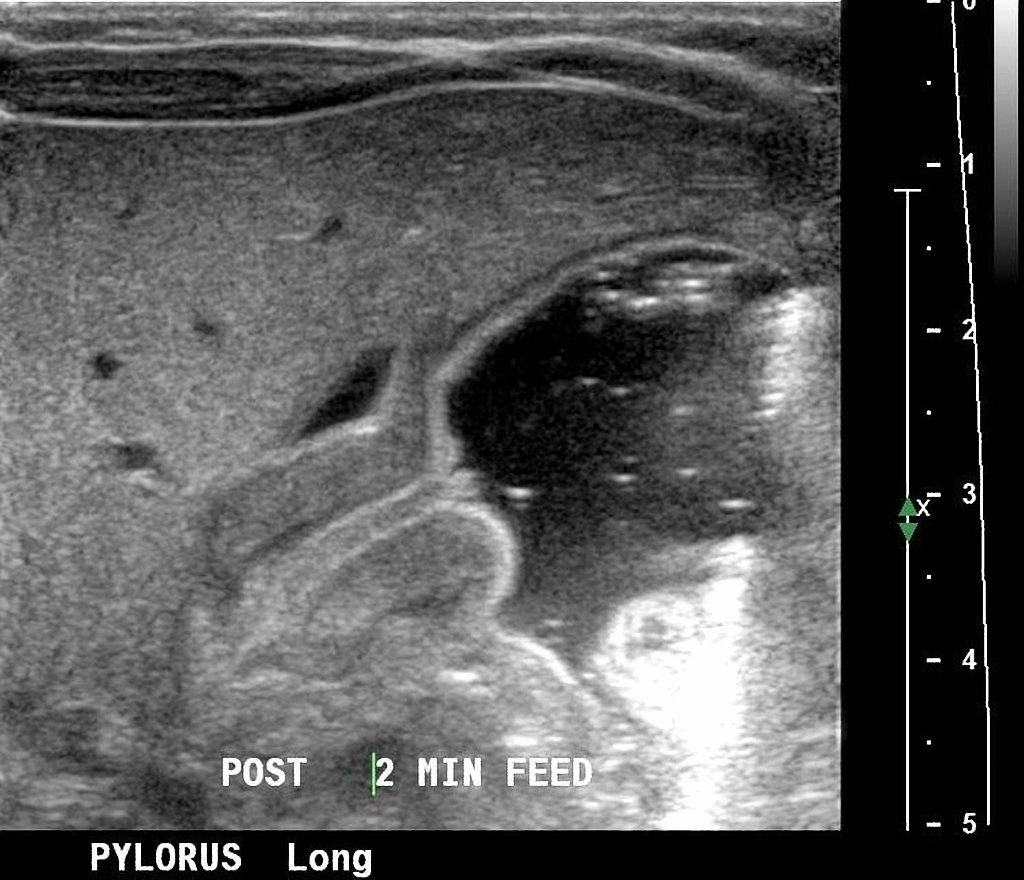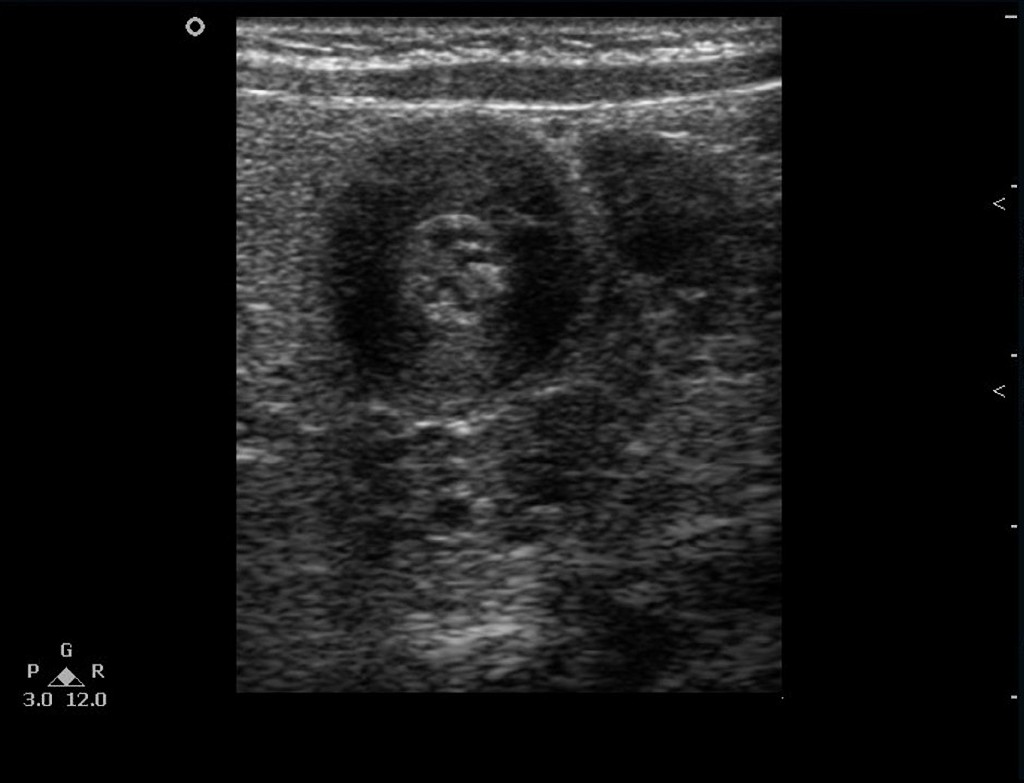Pyloric stenosis ultrasound: Difference between revisions
Jump to navigation
Jump to search
No edit summary |
No edit summary |
||
| Line 14: | Line 14: | ||
**Intervening [[mucosa]] is crowded, thickened to a variable degree, and protrudes into the distended portion of the [[antrum]] '''nipple sign'''<ref name="urlAntral nipple sign | Radiology Reference Article | Radiopaedia.org">{{cite web |url=https://radiopaedia.org/articles/antral-nipple-sign |title=Antral nipple sign | Radiology Reference Article | Radiopaedia.org |format= |work= |accessdate=}}</ref> | **Intervening [[mucosa]] is crowded, thickened to a variable degree, and protrudes into the distended portion of the [[antrum]] '''nipple sign'''<ref name="urlAntral nipple sign | Radiology Reference Article | Radiopaedia.org">{{cite web |url=https://radiopaedia.org/articles/antral-nipple-sign |title=Antral nipple sign | Radiology Reference Article | Radiopaedia.org |format= |work= |accessdate=}}</ref> | ||
**Protruded [[mucosa]] may be seen filling the [[lumen]] on transverse sections. | **Protruded [[mucosa]] may be seen filling the [[lumen]] on transverse sections. | ||
**The '''target sign''' of infantile pyloric stenosis is a sign seen due to hypertrophied hypoechoic muscle surrounding echogenic mucosa. This is likened to that of a target. | **The '''target sign''' of infantile pyloric stenosis is a sign seen due to hypertrophied hypoechoic muscle surrounding echogenic mucosa<ref name="pmid21475495">{{cite journal| author=Hussain M| title=Sonographic Diagnosis of Infantile Hypertrophic Pyloric stenosis- Use of Simultaneous Grey-scale & Colour Doppler Examination. | journal=Int J Health Sci (Qassim) | year= 2008 | volume= 2 | issue= 2 | pages= 134-40 | pmid=21475495 | doi= | pmc=3068743 | url=https://www.ncbi.nlm.nih.gov/entrez/eutils/elink.fcgi?dbfrom=pubmed&tool=sumsearch.org/cite&retmode=ref&cmd=prlinks&id=21475495 }} </ref>. This is likened to that of a target. | ||
(Images courtesy of RadsWiki) | (Images courtesy of RadsWiki) | ||
Revision as of 17:14, 6 December 2017
|
Pyloric stenosis Microchapters |
|
Diagnosis |
|---|
|
Treatment |
|
Case Studies |
|
Pyloric stenosis ultrasound On the Web |
|
American Roentgen Ray Society Images of Pyloric stenosis ultrasound |
|
Risk calculators and risk factors for Pyloric stenosis ultrasound |
Editor-In-Chief: C. Michael Gibson, M.S., M.D. [1] Associate Editor(s)-in-Chief: Mohamadmostafa Jahansouz M.D.[2]
Overview
Ultrasonography demonstrates the thickened prepyloric antrum bridging the duodenal bulb and distended stomach and it is the modality of choice for the diagnosis of infantile pyloric stenosis.
Ultrasound
Ultrasonography is the modality of choice for the diagnosis of infantile pyloric stenosis.[1]
- Ultrasonography demonstrates the thickened pre-pyloric antrum bridging the duodenal bulb and distended stomach in patients with infantile pyloric stenosis.
- Demonstration of the pylorus is achieved by identifying the duodenal cap, distended stomach, and intervening pyloric channel.
- In patients with pyloric stenosis, the following findings may be observed on ultrasonography:
- Variable hypertrophy of the smooth muscle
- Intervening mucosa is crowded, thickened to a variable degree, and protrudes into the distended portion of the antrum nipple sign[2]
- Protruded mucosa may be seen filling the lumen on transverse sections.
- The target sign of infantile pyloric stenosis is a sign seen due to hypertrophied hypoechoic muscle surrounding echogenic mucosa[3]. This is likened to that of a target.
(Images courtesy of RadsWiki)


References
- ↑ Costa Dias S, Swinson S, Torrão H, Gonçalves L, Kurochka S, Vaz CP; et al. (2012). "Hypertrophic pyloric stenosis: tips and tricks for ultrasound diagnosis". Insights Imaging. 3 (3): 247–50. doi:10.1007/s13244-012-0168-x. PMC 3369120. PMID 22696086.
- ↑ "Antral nipple sign | Radiology Reference Article | Radiopaedia.org".
- ↑ Hussain M (2008). "Sonographic Diagnosis of Infantile Hypertrophic Pyloric stenosis- Use of Simultaneous Grey-scale & Colour Doppler Examination". Int J Health Sci (Qassim). 2 (2): 134–40. PMC 3068743. PMID 21475495.